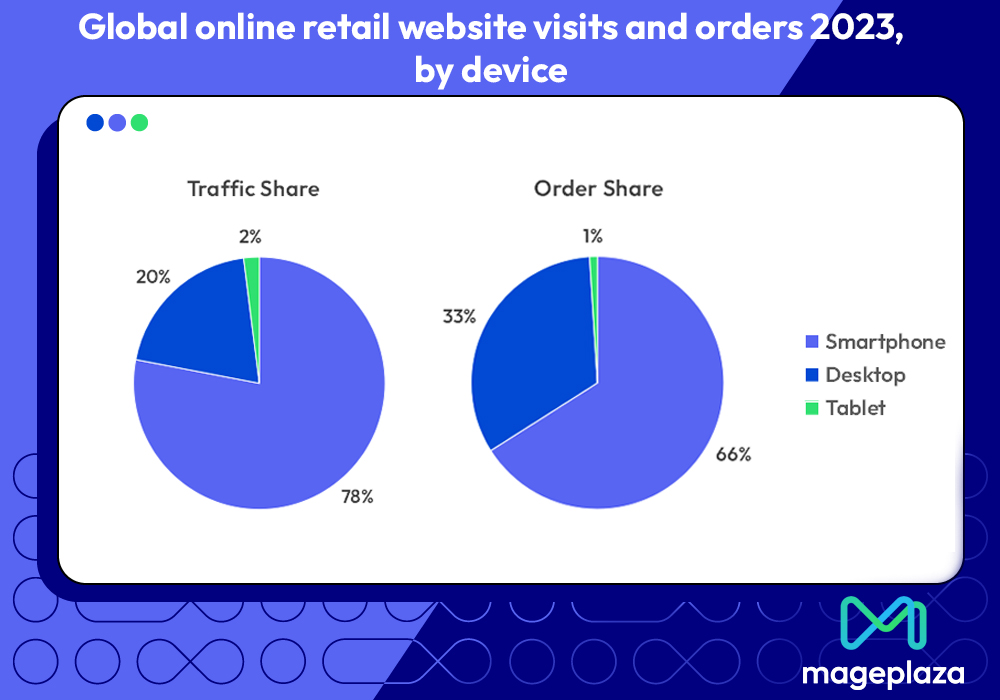50+ Latest Website Design Statistics in 2024
Summer Nguyen | 07-29-2024

In 2024, website design will be a crucial element of business strategy and user engagement. As the digital landscape evolves, keeping up with the latest web design trends and statistics is essential. From the rise of mobile usage to the importance of UX and UI design, understanding these trends helps businesses stay competitive and improve user satisfaction.
The web design industry is growing and diversifying, with the U.S. market for web design services valued at $40.8 billion. Employment of web developers and designers is projected to grow by 16% from 2022 to 2032.
This blog post explores over 50 key web design statistics, covering industry growth, website traffic, user experience, mobile optimization, UI/UX design, e-commerce, and styling. Understanding these statistics helps businesses enhance their digital presence and user engagement.
Free 1-1 consultation: Website Design Service
Website design industry statistics

- The global web design services market size in the U.S. is valued at $40.8 billion, reflecting robust demand for professional web design services.
- Employment of web developers and designers is projected to grow by 16% from 2022 to 2032, significantly faster than the average for all occupations, indicating increasing demand for skilled professionals.
- WordPress powers approximately 43% of all websites, making it the leading CMS due to its user-friendly interface, extensive plugin ecosystem, and flexibility.
- With mobile internet usage surpassing desktop, web designers are prioritizing responsive designs that ensure seamless user experiences across devices. 74% of users are more likely to return to a website if it is mobile-friendly.
- The rise of online shopping drives e-commerce websites to focus on fast loading times, intuitive navigation, and secure checkout processes. Slow-loading websites costs retailers $2.6 billion in lost sales annually, highlighting the need for optimized web design.
Website design and website traffic statistics
- 94% of first impressions are related to your site’s web design. A well-designed website can significantly improve traffic by attracting and retaining visitors.
- A poorly designed website can lead to high bounce rates. Research shows that 38% of users will stop engaging with a website if the content or layout is unattractive.
- Websites that load within 2 seconds have an average bounce rate of 9%, while those that take 5 seconds to load see a bounce rate of 38%. Faster loading times not only keep visitors but also improve search engine rankings, driving more traffic.

- 57% of internet users say they won’t recommend a business with a poorly designed mobile site. Responsive design is critical as mobile traffic continues to grow, accounting for over half of global web traffic.
- Good web design improves SEO. Websites with structured layouts, clean code, and fast load times rank higher on search engines, leading to increased organic traffic. Google prioritizes user experience, making elements like mobile-friendliness and fast loading speeds crucial for visibility.
- 70% of people look at lists with bullets (like this one), and 50% look at lists with numbers. Easy-to-navigate websites keep users engaged and reduce bounce rates. Clear and intuitive navigation enhances user experience and encourages more extended visits.
Website optimization and user experience statistics
Website design plays a crucial role in user experience (UX), and the numbers clearly show its impact:
- According to research, 94% of negative feedback on websites is design-related. This underscores the importance of a visually appealing and well-structured website to make a strong first impression.
- A staggering 88% of online consumers are less likely to return to a site after a bad experience. This statistic highlights the critical nature of good design in retaining users and encouraging repeat visits.
- Poor navigation frustrates users, leading to higher bounce rates. Studies indicate that 50% of users utilize the navigation menu to orient themselves on a new site. Clear and intuitive navigation can significantly enhance user experience and keep visitors engaged longer.
- 47% of consumers expect a web page to load in 2 seconds or less.
- 57% of users say they won’t recommend a business with a poorly designed mobile site, emphasizing the need for mobile optimization.
- Inclusive design is essential for reaching a broader audience. Websites that follow accessibility best practices not only serve all users better but also rank higher in search engine results. This practice increases overall traffic and user satisfaction.
By focusing on these critical design aspects, businesses can create a more enjoyable, efficient, and engaging user experience, ultimately driving higher retention and conversion rates.
Mobile Website Design Statistics
In today’s digital age, optimizing websites for mobile devices is no longer optional—it’s a necessity. With mobile traffic surpassing desktop usage, businesses must ensure their websites are mobile-friendly to stay competitive. Here are some key statistics that highlight the importance of mobile web design:
- An overwhelming 78% of e-commerce traffic worldwide comes from smartphones. This statistic alone underscores the critical need for mobile optimization to capture and retain mobile shoppers.

- Mobile devices now account for 60% of all e-commerce sales globally. This shift towards mobile shopping means that businesses without mobile-optimized sites are potentially missing out on a significant portion of their audience.
- Speed is crucial for mobile users. 74% of users are more likely to return to a website if it is mobile-friendly. Moreover, 57% of users say they won’t recommend a business with a poorly designed mobile site. These numbers highlight the importance of a seamless mobile experience.
- Mobile optimization directly impacts conversion rates. Websites optimized for mobile devices see conversion rates that are 64% higher than those that are not. This demonstrates that a mobile-friendly site can significantly boost sales and customer satisfaction.
- Fast-loading websites are essential for retaining mobile users. Studies show that a one-second delay in mobile page load can decrease conversions by up to 20%. Ensuring quick load times is vital for maintaining user engagement and minimizing bounce rates.
- Interactive and responsive design elements enhance user engagement on mobile sites. Features like touch-friendly navigation, easy-to-read fonts, and clear call-to-action buttons are crucial. According to Forrester, mobile-optimized websites can increase user engagement by up to 30%.
- Google prioritizes mobile-friendly websites in its search rankings. This means that mobile optimization is not only beneficial for user experience but also essential for visibility in search engine results. Websites that are not mobile-friendly may suffer lower rankings, leading to decreased traffic.
- Users have little patience for poorly performing mobile sites. About 61% of users are unlikely to return to a mobile site they had trouble accessing, and 40% would visit a competitor’s site instead.
In summary, mobile website design is a critical aspect of modern web development. Businesses that prioritize mobile optimization can expect higher engagement, better conversion rates, improved user satisfaction, and enhanced SEO performance. As mobile usage continues to grow, ensuring your website provides a seamless mobile experience is essential for staying competitive in today’s digital landscape.
UI/UX website design statistics

Good UI (User Interface) and UX (User Experience) design are critical for creating effective websites that attract and retain users. Here’s how they impact user experience and business success, supported by key web design statistics:
- First impressions are overwhelmingly design-related, with 94% of users citing web design as a reason they mistrust or reject a website. This highlights the importance of investing in high-quality design to build credibility.
- Bad user experiences significantly impact return rates, as 88% of online consumers are less likely to return to a site after a bad experience. Ensuring a positive experience is essential for retaining visitors.
- Clear and intuitive navigation is crucial, with 60% of users saying they will not return to a site that is hard to navigate. Simplifying navigation helps keep users engaged and reduces bounce rates.
- A seamless mobile experience is vital, with 85% of adults believing that a company’s mobile site should be as good as or better than the desktop site. This is crucial as mobile usage continues to rise.
- Speed is a key factor, with 53% of mobile users abandoning sites that take longer than three seconds to load. Faster loading times improve user satisfaction and search engine rankings.
- Inclusive design broadens your audience reach, as websites adhering to accessibility standards offer better experiences for all users. Accessible sites also benefit from better SEO performance.
- Well-designed UI/UX can boost conversion rates significantly. Websites optimized for user experience see up to 200% higher conversion rates compared to those that do not.
- Positive UX fosters loyalty, with 74% of users more likely to return to a site with a good mobile experience. Loyal users often translate into repeat customers and long-term business success.
These statistics underscore the critical role of UI/UX in web design, emphasizing the need for businesses to focus on user-friendly, aesthetically pleasing, and efficient websites to drive engagement and conversions.
E-commerce web design statistics
Effective web design is crucial for e-commerce sites to convert visitors into customers and drive sales. Here are some key web design statistics that illustrate its impact:
- A significant 85% of shoppers consider detailed product information and high-quality images crucial when deciding which brand or retailer to buy from. Clear and comprehensive product pages enhance user trust and encourage purchases.
- About 90% of users continue shopping because of a positive user experience. This highlights the importance of a seamless, intuitive shopping journey.
- Slow-loading websites are costly, with retailers losing approximately $2.6 billion in sales annually due to slow load times. Ensuring fast loading speeds is vital for keeping users engaged and reducing bounce rates.
- 78% of shoppers want e-commerce sites to include more images on their product pages. High-quality visuals can significantly enhance the user experience and increase conversion rates.
- Usability issues can lead to high cart abandonment rates. Around 60% of consumers rate usability as an important design characteristic for an online shop. Simplifying the checkout process can help reduce cart abandonment.
- E-commerce sites with optimized web design rank better on search engines. This improved visibility drives organic traffic, which is crucial for sales. Google prioritizes user-friendly, fast-loading websites in its rankings.
- Trust is a significant factor in online shopping. Websites with professional design elements and clear security features (like SSL certificates) foster consumer trust, leading to higher conversion rates).
These statistics underscore the critical role of web design in e-commerce, emphasizing the need for detailed product pages, fast loading speeds, mobile optimization, and an overall positive user experience to drive sales and customer loyalty.
Website design styling statistics
The visual appeal of a website plays a critical role in attracting and retaining users. Here are some key web design statistics that highlight the importance of styling in web design:

- 46% of users base their decisions on the visual appeal of a website. This emphasizes the need for a well-designed, aesthetically pleasing website to make a positive first impression.
- A significant 59% of users prefer browsing beautifully designed websites over simple, plain ones when given 15 minutes to consume content. This indicates that investing in high-quality design can engage users more effectively.
- 57% of users say they won’t recommend a business with a poorly designed mobile site. Ensuring that your mobile design is as appealing and functional as your desktop version is crucial for user retention and recommendations.
- 78% of shoppers want e-commerce sites to include more images on their product pages. High-quality visuals not only enhance the user experience but also help in making informed purchasing decisions.
- Websites with professional and appealing design elements tend to have higher conversion rates. Good design fosters trust and credibility, which are essential for converting visitors into customers.
These statistics demonstrate the critical role of website styling in enhancing user experience, building trust, and driving engagement and conversions. Investing in high-quality, visually appealing design is essential for any business looking to succeed online.
Conclusion
Staying updated with the latest web design statistics is essential for creating effective, user-friendly websites that drive engagement and conversions. The data highlights the importance of mobile optimization, fast loading speeds, and high-quality UI/UX design. With the web design industry continuing to grow and diversify, businesses must focus on these key areas to remain competitive. By leveraging these insights, companies can enhance their digital presence, improve user satisfaction, and achieve better business outcomes.







